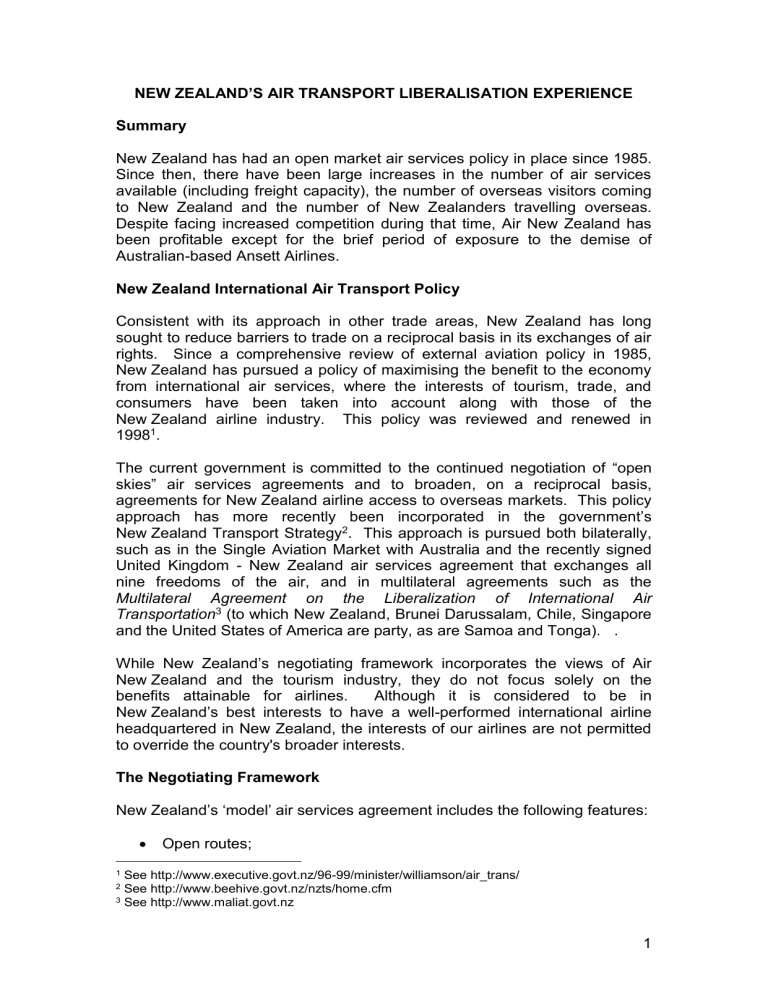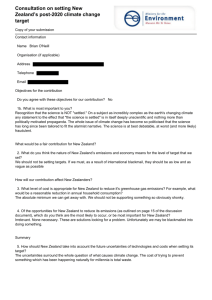New Zealand's Air Transport Liberalisation Experience

NEW ZEALAND’S AIR TRANSPORT LIBERALISATION EXPERIENCE
Summary
New Zealand has had an open market air services policy in place since 1985.
Since then, there have been large increases in the number of air services available (including freight capacity), the number of overseas visitors coming to New Zealand and the number of New Zealanders travelling overseas.
Despite facing increased competition during that time, Air New Zealand has been profitable except for the brief period of exposure to the demise of
Australian-based Ansett Airlines.
New Zealand International Air Transport Policy
Consistent with its approach in other trade areas, New Zealand has long sought to reduce barriers to trade on a reciprocal basis in its exchanges of air rights. Since a comprehensive review of external aviation policy in 1985,
New Zealand has pursued a policy of maximising the benefit to the economy from international air services, where the interests of tourism, trade, and consumers have been taken into account along with those of the
New Zealand airline industry. This policy was reviewed and renewed in
1998 1 .
The current government is committed to the continued negotiation of
“open skies
” air services agreements and to broaden, on a reciprocal basis, agreements for New Zealand airline access to overseas markets. This policy approach has more recently been incor porated in the government’s
New Zealand Transport Strategy 2 . This approach is pursued both bilaterally, such as in the Single Aviation Market with Australia and the recently signed
United Kingdom - New Zealand air services agreement that exchanges all nine freedoms of the air, and in multilateral agreements such as the
Multilateral Agreement on the Liberalization of International Air
Transportation 3 (to which New Zealand, Brunei Darussalam, Chile, Singapore and the United States of America are party, as are Samoa and Tonga). .
While New Zealand’s negotiating framework incorporates the views of Air
New Zealand and the tourism industry, they do not focus solely on the benefits attainable for airlines. Although it is considered to be in
New Zealand’s best interests to have a well-performed international airline headquartered in New Zealand, the interests of our airlines are not permitted to override the country's broader interests.
The Negotiating Framework
New Zealand’s ‘model’ air services agreement includes the following features:
Open routes;
1 See http://www.executive.govt.nz/96-99/minister/williamson/air_trans/
2 See http://www.beehive.govt.nz/nzts/home.cfm
3 See http://www.maliat.govt.nz
1
Open capacity;
Full traffic rights including seventh freedom and cabotage;
Designation provisions based around principal place of business, place of incorporation and effective control;
Provision for code-sharing, including third country code-sharing;
No industry-specific regulation of tariffs; and
Flexibility for airlines by allowing for leasing, change of gauge, etc.
New Zealand negotiators ensure that New Zealand airlines gain a fair and equal opportunity to compete even if they have no current intention of doing so. If the other country is restricted in its approach then the package agreed may fall short of full liber alisation for that party’s airlines. In arriving at an agreed package, however, due weight is given to both the general desire of the tourism industry to see passenger numbers increase and to exporters’ needs for freight capacity.
Airline Investment
Consistent with ICAO recommendations, New Zealand seeks to provide for open investment in international airlines. Reducing barriers to foreign investment in international airlines is increasingly common world-wide, especially as airlines are privatised. ICAO is encouraging states to consider a liberal approach in which the designation criteria are principal place of business and effective regulatory control. New Zealand has agreed these criteria in its Air Services Agreement signed with Viet Nam in October 2003.
Generally, however, New Zealand seeks to replace the traditional “substantial ownership” criterion with criteria relating to the “place of incorporation and principal place of business” of an airline, while retaining the provision that the airline may be refused operating authorisation if it is not effectively controlled by nationals of the party designating it. Bilateral partners have responded positively to the new criteria and a significant number have agreed to the removal of ownership restrictions. There are no ownership restrictions in the
Multilateral Agreement on the Liberalization of International Air Transportation .
Under current New Zealand policy an airline has to be substantially owned and effectively controlled by New Zealand nationals before it can be designated by New Zealand to operate services under any of New
Zealand’s
ASAs. This will remain the policy until such time as the government can be confident that a New Zealand airline would not be denied access to traffic rights if it is not substantially owned by New Zealand nationals. New Zealand considers there are still a small number of markets, including within APEC, from which Air New Zealand could be excluded if the airline were to become substantially owned and effectively controlled by non-New Zealand nationals.
Tariffs Regulation
New Zealand’s standard approach is to seek to remove all tariff filing requirements from air services agreements. By doing so, airlines are given the ability to respond quickly to market developments, without waiting for
2
government consideration and approval, and there is a reduced administrative burden on airlines and governments. Airlines have the option of filing tariffs for authorisation. This is in situations where a tariff has been jointly agreed with other carriers. When authorisation is given in such circumstances the tariff is taken outside the jurisdiction of New Zealand’s competition authorities.
5 th freedom rights: Opportunities and Competition
For a country like New Zealand, exposed to the pressures arising from longdistances to most tourism origin markets, the ability of overseas airlines to code-share and exercise 5 th freedom rights provides additional options for consumers. The services of carriers such as Royal Brunei, Thai Airways,
Garuda Indonesia, Aerolineas Argentinas, Emirates and Lan Airlines all provide New Zealand with connections to important parts of the world. These services might not be available, however, if the airlines did not have access to
5 th freedom rights between New Zealand and Australia. In cases where no
‘home’ country carrier is operating, 5 th freedom services may provide the only alternative for consumers. In air services markets where there is no provision for fifth freedom carriers to compete, fares are higher than they would be if such competition were allowed. This is detrimental to the interests of consumers.
Of New Zealand’s 46 air services relationships (of which 17 are open arrangements), only six do not include any exchange of 5 th freedom rights. In respect of the six, these are agreements predicated on perceived code-share opportunities for the airlines of both countries, rather than on any expectation that the airlines of either side would operate services with their own aircraft.
A particular case of the ability to serve multiple points leading to airlines providing additional services is evident with cargo-only services. Cargolux and Singapore Airlines Cargo have been among the main providers of dedicated cargo services to New Zealand. The ability of these air services to carry New Zealand products to markets other than Luxembourg and
Singapore exists because 5 th freedom rights are included in our agreements with those countries. Air New Zealand has recently commenced a twiceweekly round-the-world freighter service, with a wet-leased B747, using open traffic rights New Zealand has exchanged with each of Australia, China,
Germany and the United States. Without 5 th freedom rights, it is most unlikely that cargo airlines would serve New Zealand at all, to the detriment of our economy.
Code-sharing
Code-sharing, including third-country code-sharing provides opportunities for airlines to develop or sustain markets that would be difficult to support with own-aircraft operations. Code-sharing is also a very effective means of implementing global airline alliances. Third-country code-sharing is explicitly permitted in 36 of New Zealand’s air services relationships (those where it is not provided for are mainly older relationships where no recent negotiations have been held).
3
Ten airlines currently offer services to New Zealand on a code-share only basis.
Outcomes
In 1985 New Zealand was a party to only 12 air services relationships.
Between 1985 and July 2005, 34 new air services agreements were negotiated, while the original 12 have all been either replaced or had new opportunities created. This has resulted in a significant increase in the number of airlines serving New Zealand since the beginning of 1985. Of the passenger airlines now operating to New Zealand with their own aircraft, 13 were not operating to New Zealand at the commencement of 1985. Similarly, seven code-sharing carriers now serving New Zealand were not present at the start of 1985. A number of cargo-only carriers have also commenced services to/from New Zealand in that time.
The number of overseas visitors coming to New Zealand increased from
670,000 in 1985 to 2,530,000 (+278%) in the year ended July 2005 and the number of New Zealanders travelling overseas increased from 378,000 to
1,806,000 (+378%) during the same period.
Tourism is now New Zealand’s largest export earner, with almost all visitors to New Zealand arriving by air.
The open arrangements New Zealand has negotiated have given airlines the ability to forward plan confident in the knowledge that the necessary air rights will be available. Our experience has been that the only shortages of capacity have been in markets with restricted air services arrangements and airlines have generally been able to introduce extra capacity in accordance with market demand.
Conclusion
The continued negotiation of open market air services arrangements:
keeps the New Zealand airline industry on a similar footing to other industries competing internationally;
provides a wide range of opportunities for Air New Zealand, offering the opportunity to introduce, expand or vary services at short notice;
provides a wide range of opportunities for overseas airlines to introduce, add or vary services to New Zealand; and
leads to meeting the needs of New Zealand consumers, airlines, the tourism industry, and our exporters and importers.
4







